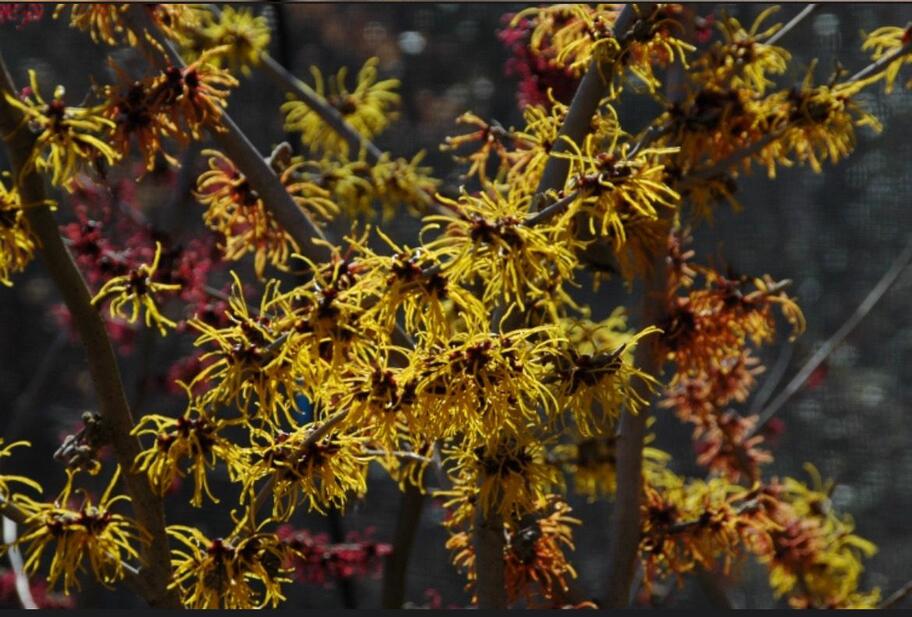Witch Hazel: Harbingers Of Survival
By: Braxton B.
Age: 16
Atlanta, Georgia, USA
By: Braxton B.
Age: 16
Atlanta, Georgia, USA
 Photo Credit: Braxton B
Photo Credit: Braxton B
In the barren landscape of winter, when most vegetation goes dormant, one plant begins to flourish. Hamamelis ovalis, or Leonard’s Witch Hazel, blooms in colors ranging from a pale yellow to deep red in the heart of winter. Flowers, often associated with the spring and summer, are a rare occurrence that early in the year, making the flowers an important source of carbohydrates for pollinators like flies, moths, and some hardy species of butterflies. Leonard’s Witch Hazel is a large, deciduous shrub native to the Southeastern United States. It is an understory plant that can reach heights of up to 15 feet and grows best in areas with ample shade.
While the exterior of Hamamelis ovalis is certainly captivating, its interior is just as, if not more fascinating. Leonard’s Witch Hazel has both anti-inflammatory and antioxidant properties, meaning extracts of the plant can aid the body in reducing inflammation. These benefits have been appreciated for centuries, as several Native American tribes have used the plant to treat an array of ailments, from colds and sore muscles to hemorrhoids and ulcers. The plant is also popular in the cosmetic industry for its astringent properties known to soothe skin. Witch hazel is found in products used to treat acne and oily skin and hair, as well as to tighten pores. It is a key ingredient in many toners, shampoos, soaps, and pore strips.
Despite the plant’s ubiquity on store shelves, the United States Department of Agriculture has described the conservation status of the Hamamelis ovalis as “critically impaired,” meaning it is extremely rare in the wild. To help rectify this problem, Leonard’s Witch Hazel can be planted in home gardens across the Southeast. In areas the plant is native to, Witch Hazel is a painless addition to gardens and can even be grown in pots outdoors. By growing the plant at home, its population can reclaim its vigor, and all of its ecological, medicinal, and cosmetic benefits can be enjoyed, something I personally cannot wait to experience.
Bibliography
Andriote, J.-M. (2012, November 6). The Mysterious Past and Present of Witch Hazel. The Atlantic. https://www.theatlantic.com/health/archive/2012/11/the-mysterious-past-and-present-of-witch-hazel/264553/.
Bell, N., Stoven, H., & Melathopoulos, A. (2020, March). Trees and Shrubs for Fall and Winter Bloom. catalog.extension.oregonstate.edu. https://catalog.extension.oregonstate.edu/sites/catalog/files/project/pdf/em9277.pdf.
Gordon, K. L. (n.d.). Big-leaf witch-hazel (Hamamelis ovalis). Forest Service Shield. https://www.fs.fed.us/wildflowers/plant-of-the-week/hamamelis_ovalis.shtml.
Thring, T. S., Hili, P., & Naughton, D. P. (2011, October 13). Antioxidant and potential anti-inflammatory activity of extracts and formulations of white tea, rose, and witch hazel on primary human dermal fibroblast cells. Journal of inflammation (London, England). https://www.ncbi.nlm.nih.gov/pmc/articles/PMC3214789/.
While the exterior of Hamamelis ovalis is certainly captivating, its interior is just as, if not more fascinating. Leonard’s Witch Hazel has both anti-inflammatory and antioxidant properties, meaning extracts of the plant can aid the body in reducing inflammation. These benefits have been appreciated for centuries, as several Native American tribes have used the plant to treat an array of ailments, from colds and sore muscles to hemorrhoids and ulcers. The plant is also popular in the cosmetic industry for its astringent properties known to soothe skin. Witch hazel is found in products used to treat acne and oily skin and hair, as well as to tighten pores. It is a key ingredient in many toners, shampoos, soaps, and pore strips.
Despite the plant’s ubiquity on store shelves, the United States Department of Agriculture has described the conservation status of the Hamamelis ovalis as “critically impaired,” meaning it is extremely rare in the wild. To help rectify this problem, Leonard’s Witch Hazel can be planted in home gardens across the Southeast. In areas the plant is native to, Witch Hazel is a painless addition to gardens and can even be grown in pots outdoors. By growing the plant at home, its population can reclaim its vigor, and all of its ecological, medicinal, and cosmetic benefits can be enjoyed, something I personally cannot wait to experience.
Bibliography
Andriote, J.-M. (2012, November 6). The Mysterious Past and Present of Witch Hazel. The Atlantic. https://www.theatlantic.com/health/archive/2012/11/the-mysterious-past-and-present-of-witch-hazel/264553/.
Bell, N., Stoven, H., & Melathopoulos, A. (2020, March). Trees and Shrubs for Fall and Winter Bloom. catalog.extension.oregonstate.edu. https://catalog.extension.oregonstate.edu/sites/catalog/files/project/pdf/em9277.pdf.
Gordon, K. L. (n.d.). Big-leaf witch-hazel (Hamamelis ovalis). Forest Service Shield. https://www.fs.fed.us/wildflowers/plant-of-the-week/hamamelis_ovalis.shtml.
Thring, T. S., Hili, P., & Naughton, D. P. (2011, October 13). Antioxidant and potential anti-inflammatory activity of extracts and formulations of white tea, rose, and witch hazel on primary human dermal fibroblast cells. Journal of inflammation (London, England). https://www.ncbi.nlm.nih.gov/pmc/articles/PMC3214789/.
Editor's note
Wildlife In Spotlight collaborated with six students who attended the Summer High School Leadership Summit at the Atlanta Botanical Garden. As part of Braxton's two-week program, he had to research, write and present on a plant of his choice. He met with horticulturists, conservationists and other experts to explore the Garden's collections and gather information to write his article. Students were encouraged to select plants that not only interested them, but also had ecological, ethnobotanical, or economic value.
Many thanks to Lorin Boren, School Program Assistant Manager, Atlanta Botanical Garden for coordinating and facilitating this partnership!
Wildlife In Spotlight collaborated with six students who attended the Summer High School Leadership Summit at the Atlanta Botanical Garden. As part of Braxton's two-week program, he had to research, write and present on a plant of his choice. He met with horticulturists, conservationists and other experts to explore the Garden's collections and gather information to write his article. Students were encouraged to select plants that not only interested them, but also had ecological, ethnobotanical, or economic value.
Many thanks to Lorin Boren, School Program Assistant Manager, Atlanta Botanical Garden for coordinating and facilitating this partnership!
